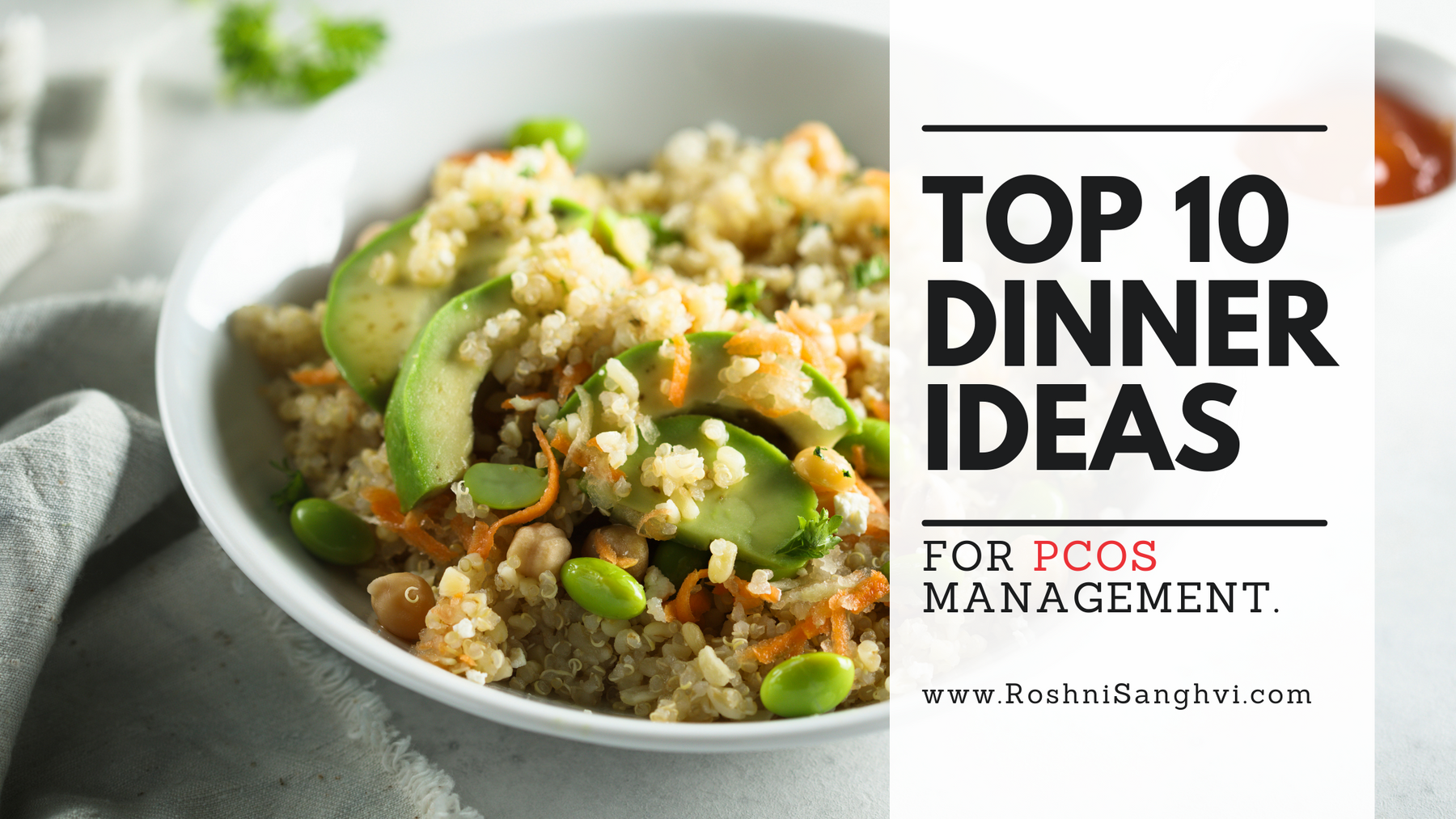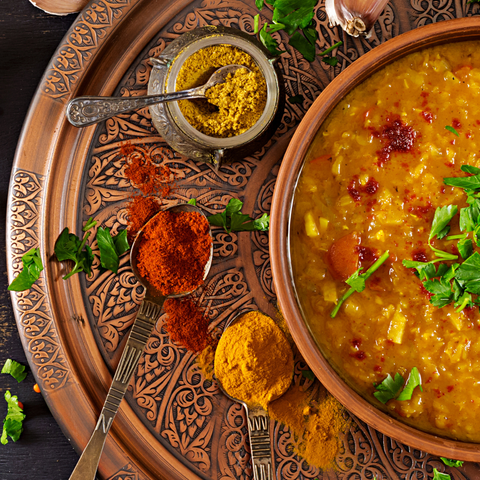
Top 10 Dinner recipes for PCOS Management.
Table Of Content
Nutrition is a major part of your lifestyle and well-being. Clearly, it is important to fix your nutrition to deal with a lifestyle disorder like PCOS.
A woman’s food habits play a role in increasing or decreasing the estrogen and androgen levels (sex hormones) in her blood. The same can either worse your PCOS symptoms or heal your body.

Moreover, excess body fat is a major concern in PCOS patients because fat cells are mini hormone making factories. Thus, the excess weight you carry, leads to excess hormone production.
Before getting to the recipes, let’s understand what kind of food should someone struggling with PCOS eat?
Why nutrition matters.
Most doctors prescribe birth control pills to PCOS patients. These medications can definitely help regulate your periods. But they do come with side effects such as nausea, weight gain, and headaches and put you at risk of heart diseases. Long term intake of the pill can also affect your fertility.
Would you not want your food to help you get rid of PCOS? After helping thousands of women reverse PCOS across the globe, I can confidently say that nutrition plays a very important role. The key however is to make sustainable lifestyle changes and not fad low- calories diets that you cannot stick to for the rest of your life.
If you want to understand a detailed nutrition plan to help manage PCOS, the read this article I wrote:
In a list though, if you have PCOS, you must avoid:
- Animal derived products such as meat, fish, eggs, milk, cheese, ghee, butter, and paneer.
- Use minimum cooking oil's (even cold-pressed oils and extra virgin olive oil)
- Avoid high Glycemic Index (GI) foods such as refined sugar and refined flour or maida (for example, white bread)
Before you say, ‘that’s insane!’, the recipes below will help you understand that it really is not that hard.
Alternatively, you need to choose a whole food plant based diet that comprises abundant fruits, veggies, legumes, pulses, grains, nuts, and seeds. These foods are naturally low in fat and high in fiber.

Now here is the wonderful part, no portion control is needed when you are on a whole food plant based diet. You can eat to your heart’s content, unlike other weight loss diets. Despite of not having to calculate calories or macros, you will notice that your weight comes back to its normal range in no time and stays there.
The role of fiber...
Plant-based foods are rich in fiber. The fiber in your food binds to the excess hormones in the gut and helps to flush them out. This means, by just increasing your fiber intake, you are already healing.
No the contrary, there is no fiber in animal derived foods. Animals do not make fiber, it only comes from plants. When you largely consume eggs, fish, or chicken, in your meals, not only is your body not getting enough fiber, but it is getting the growth and sex hormones from the animals too!
Not just sex hormones, fiber can help you lower cholesterol as well.
Impact of dietary AGE.
AGE's stand for advanced glycation end- products. These are inflammatory and dangerous molecules in your body that cause PCOS symptoms or make them worse.
As per a study, high Advanced Glycation End (AGE) products in meat and dairy, lead to the development of chronic disorders such as PCOS and even cancers. PCOS patients have elevated serum AGEs and this could cause symptoms like irregular periods.
A low-AGE diet comprising of fruits, veggies, grains, and legumes is known to positively impact metabolic and hormonal activities. It goes on to reduce oxidative stress and improve ovarian function in the body.
One food the most concentrated in AGE's is Ghee (clarified butter). This is one thing you want to avoid at all cost. Here is a video explaining you the same:
Going dairy-free.
Dairy products are a large part of most our households. Whether it is the milk with the morning coffee/ tea, butter and cheese with bread, cottage cheese in curries, or ghee in desserts. What we consider a rich addition to our meals is sadly deteriorating our health from within.
Simply put, when you consume dairy products, you are consuming animal hormones. This is messing up your hormonal balance, causing PCOS. Estrogen produced in pregnant cows gets transferred to the milk that humans consume.
Cows do not automatically provide us with milk. They need to be artificially impregnated year on year. In this process, they are fed poor nutrition and drugs that increase their milk production. All of this finds a way in some form in the glass of milk on our table.
Moreover, milk and cheese are high in calories and fats and comprise no fiber at all. This adds to the weight gain issue that women struggle with during PCOS. Lactose, a form of sugar present in dairy milk, could affect a woman’s ovaries and her fertility. It is anyway's difficult for a woman with PCOS to conceive and consuming dairy could be adding more strain on her body.
An ideal dinner plate...
Ideally, your dinner plate should represent this power- plate:

There should be an equal quantity of four important food groups on your dinner plate. These are, grains, lentils, vegetable's and fruits. Grains are not bad for PCOS, but having too much of grains and too little of vegetables is bad. Fruits too must be had right before dinner and are a key food group for recovery.
Here are some more key points for you to keep in mind while preparing a dinner plate:
- Include mushroom and brown rice as much as possible
Mushroom and brown rice decrease AGEs in the body. A low AGE diet can help fix insulin resistance in the case of PCOS. Try to include mushrooms and brown rice at least thrice a week in your meals.
- Include soy products
Soy is a complete plant protein comprising all nine essential amino acids. When soy replaces animal protein in your meal, it is known to alleviate PCOS symptoms such as inflammation and oxidative stress on the body. Soy on the other hand, being rich in phytoestrogen, aids in weight loss and better hormonal health.
- Introduce diverse plant food groups
Your gut health largely determines how your body will function. You can develop a healthy gut microbiome by eating a variety of seasonal plant food groups. This means not restricting your fruit intake to just apples and bananas. Or limiting your green intake with just spinach.
Can you target 30 varieties in a week? It might sound difficult at first, but once it becomes a part of your lifestyle, your body with thank you. This will not only help you with PCOS but any other psychological disorder you might be dealing with.
- Include isoflavones and phytoestrogen rich foods
Isoflavones, a type of phytoestrogen, is a compounds found in plants. They have a protective effect int he body, protecting you against cancers and post menopausal symptoms.
Soy isoflavones are known to bind with estrogen receptors and aid in reducing human estrogenic activity (if excess), inflammation management, and even boost bone density- all of which are required for PCOS. Isoflavons are largely found in soy products, but plants like flaxseeds and green tea have other phytoestrogens.
There is a type of phytoestrogen called lignan present in flaxseeds. It has a positive impact on estrogen metabolism and therefore flaxseeds must be regularly included in your diet.
10 dinner recipes for PCOS management.
Now that you have got an idea of the food ingredients that must be included in meal preparations, let’s look at some interesting recipes -
-
Amla Rasam

Amla is a rich source of vitamin C and boosts your immune system. This recipe calls for a unique way to include amla in a regular meal. Best paired with brown rice and any pulses sundal, this is an easy to prepare dish with minimal ingredients. Make sure to have a salad on the side
The recipe itself is not very calorically dense, but packed in micro nutrients, thus, making it an exceptional option for fat- loss too.
-
Jowar/ Millet Upma

Jowar is a millet that can bring plant diversity to your weekly meals. Millet's are low in GI, thus, causing less of a blood glucose spike that grains like rawa and rice. Quinoa or foxtail millets can be used instead of jowar for this dish.
This dish is also an opportunity to add vegetables to your dinner plate. I insist you use equal quantity of millets and vegetables, plus, pair the upma with a nice horse gram chutney to add some pulses. Make sure to also start your meal with a fruit to cover all the food groups!
-
Brown Rice Stir fry

As we learned earlier, brown rice reduces AGE's int he body, thus, include it as much as you can. It is also rich in fiber and magnesium.
Dinner quite honestly cannot get easier than this dish. Feel free to chop vegetables over the weekend and freeze them, thus, reducing the total cooking time for this meal to less that 15 minutes.
I would add bean sprouts to the stir fry, or pair this dish with a Turkish lentil soup. The only other thing I would change int he recipe is to make it using less than 1 tsp of oil (1 tbsp total if you are cooking for two people). Soy sauce and water is enough to stir fry the veggies if you want to make this dish oil- free.
-
Sesame Tofu and Broccoli

Thought you cannot make a stir fry without oil's? Well this recipe will surprise you! A dinner bowl by itself, or, can be paired with a grain of your choice like quinoa, brown rice or even sliced whole grain bread.
This recipe is simple and quick but goes on to include pulses (tofu), seeds, veggies, and a grain in a single meal.
-
Farro Mushroom Risotto

On the days when you are feeling fancy, you don’t have to eat out. Try this farro mushroom recipe at home instead. As we discussed earlier, mushrooms lower AGEs in your body. But besides that, this recipe is naturally oil free and also contains leafy greens.
I would pair this with a lentil stew and a cup of fruits before the meal.
-
Vegan Palak Tofu

Tofu can be replaced with paneer in most Indian recipes. Try sourcing good quality and organic tofu to include in your meal preparations.
This is a traditional Indian dish, bursting with flavour, yet, low in calories and wholesome. Pair this dish with a bowl of brown rice and boiled or sautéed vegetables on the side. Don't forget to have a cup of fruits before your meal!
-
Buddha Bowl

Buddha bowls are a great way to include small portions of different food groups in a single meal.
Try constructing your buddha bowl with at least a portion of whole grains or millets, lentils/ pulses, and vegetables of choice. You can get creative and add more stuff but these must definitely be present to get high nutritional benefits from the bowl.
-
Vegan Tofu and Bean chilli

This is a meal prep friendly recipe I insist you make on a Sunday night to last you for a few days. The recipe is also very versatile, allowing you to tweak and add any vegetables going bad in the fridge. While you can pair this dish with a slice of whole grain bread, the chilli itself is filling and you might not require to add additional grains to this dish.
-
Creamy Vegan Korma.

Another fantastic Indian recipe that can be paired with any grain of choice. I personally like to eat this Korma with Jowar or Bajra phulka's. Add as many vegetables as you can, particularly cruciferous vegetables like cauliflower.
Not only are they packed with nutrients, but also rich in cancer fighting enzymes. Cruciferous vegetables are the healthiest amongst the vegetable family.
-
Chickpea one- pot bowl

The idea is simple, cook chickpea's using any spices of your choice and pair the same with a grain source like brown rice, quinoa or foxtail millets. Also make sure to fill half your plate with raw salads and get all the benefits of chewing raw foods.
This one- pot meal is again a staple in my home, with a bold use of spices and flavouring.
Whole Food Plant Based diet for PCOS Reversal
By choosing a whole food plant based diet, very soon, your body fat starts diminishing. This improves insulin sensitivity and hormonal health. Start by switching one meal a day to make it low AGE and plant- based, and soon in no time, you would have made a lifestyle change.
If you want a step- by- step guide to reversing PCOS, please sign up here:
The above link also includes a customised low- AGE cookbook with over 111 recipes to keep you trying something new always.
If you are someone who is suffering from PCOS, the sheer volume of information available online can easily overwhelm you. You could get anxious and not know where to start. To make it simpler for you, I spent years researching and developing a PCOS reversal plan.
I have a team comprising nutritionists, gynecologist, psychologist, and fitness trainers. Although nutrition plays a key role in PCOS reversal, it is just one pillar with it comes to reversal. Lifestyle modification and changes to your fitness routine are equally important.
Looking for a PCOS Reversal through nutrition? Fill this form below to get in touch with me.
Let's Just Talk. No Obligations.
I do free consultations every Tuesday's and Thursday's. Either way you will get some actionable tips to reach your fitness goals faster.


Leave a comment